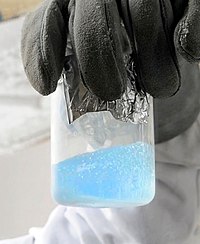
Photo from wikipedia
Simple Summary Photobiomodulation studies have reported that blue light irradiation induces the production of reactive oxygen species. We examined the effect of blue laser (405 nm) irradiation on ATP level… Click to show full abstract
Simple Summary Photobiomodulation studies have reported that blue light irradiation induces the production of reactive oxygen species. We examined the effect of blue laser (405 nm) irradiation on ATP level in the skin and measured the types of reactive oxygen species and reactive nitrogen species. The decrease in the skin ATP level due to blue light irradiation may be caused by oxidative stress due to the generation of reactive oxygen species. These findings highlight the need to consider the effects on the skin when performing photobiomodulation treatment using blue light. Abstract Photobiomodulation studies have reported that blue light irradiation induces the production of reactive oxygen species. We investigated the effect of blue laser (405 nm) irradiation on the ATP levels in mouse skin and determined the types of reactive oxygen species and reactive nitrogen species using cultured mouse fibroblasts. Blue laser irradiation caused a decrease in the ATP level in the mouse skin and triggered the generation of superoxide anion and hypochlorous acid, whereas nitric oxide and peroxynitrite were not detected. Moreover, blue laser irradiation resulted in reduced cell viability. It is believed that the decrease in the skin ATP level due to blue light irradiation results from the increased levels of oxidative stress due to the generation of reactive oxygen species. This method of systematically measuring the levels of reactive oxygen species and reactive nitrogen species may be useful for understanding the effects of irradiation conditions.
Journal Title: Biology
Year Published: 2022
Link to full text (if available)
Share on Social Media: Sign Up to like & get
recommendations!